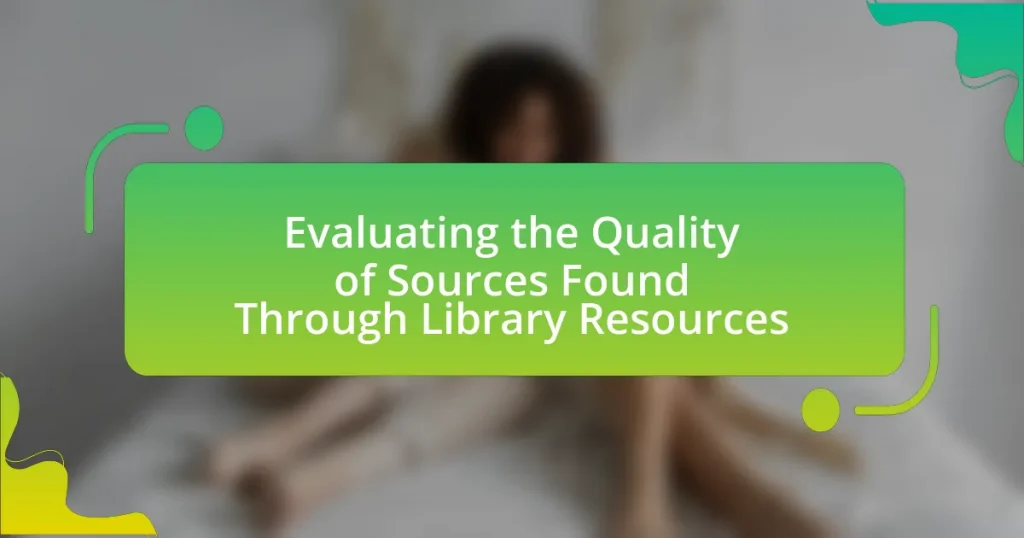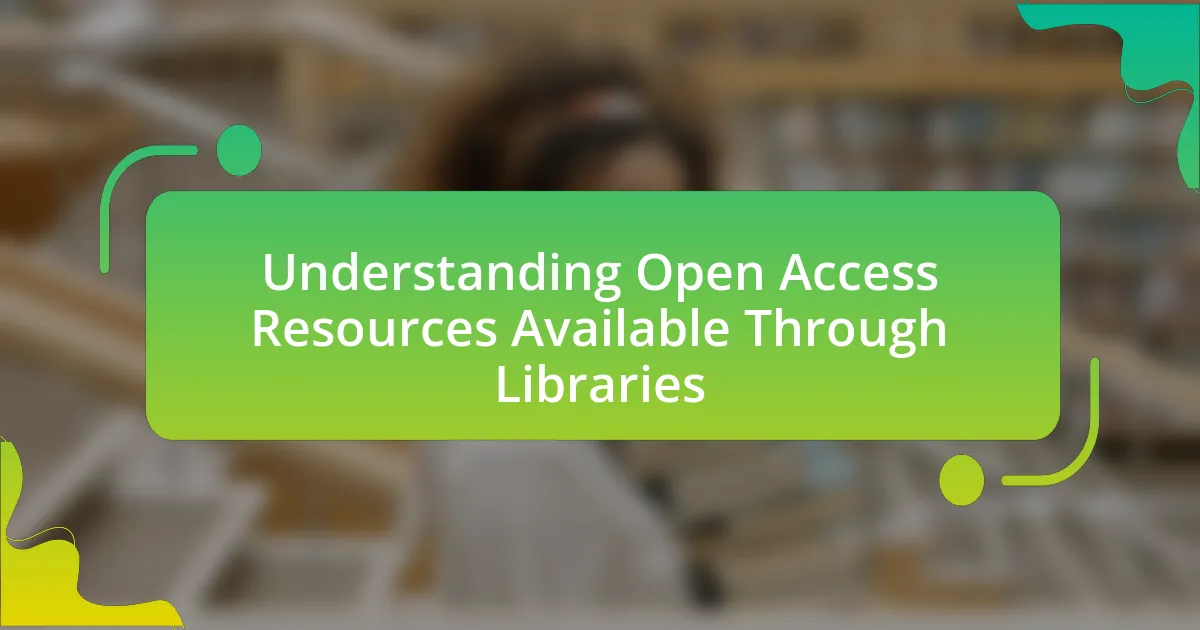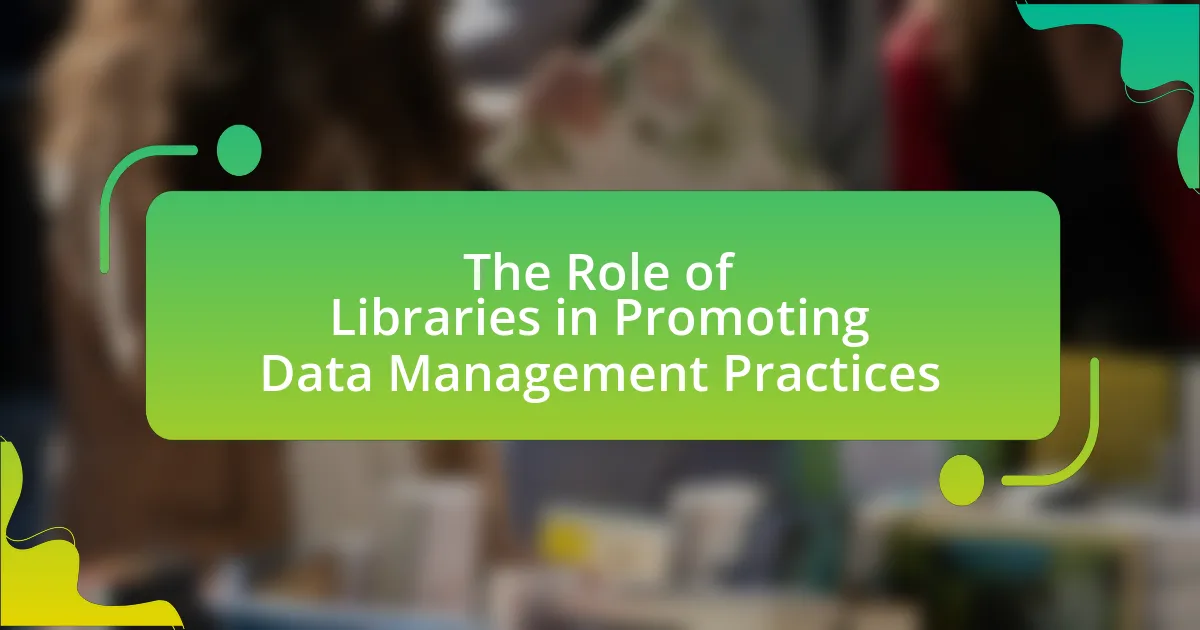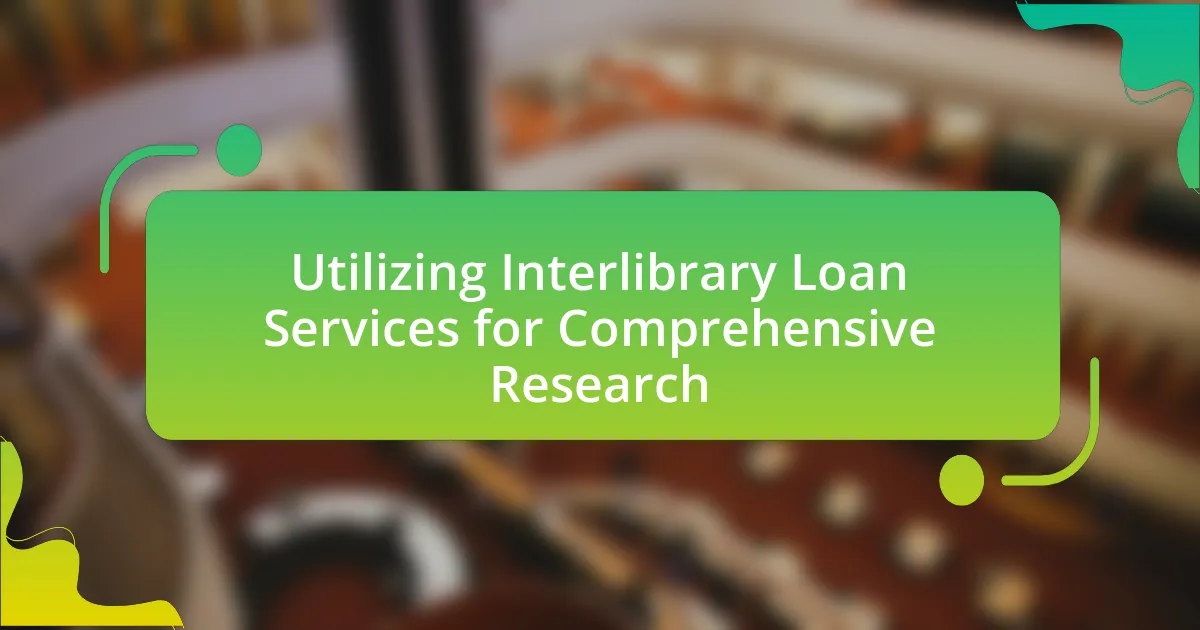Evaluating the quality of sources found through library resources is essential for ensuring the credibility, relevance, accuracy, and authority of information used in research. This article outlines the importance of source evaluation, detailing criteria such as authority, accuracy, objectivity, currency, and coverage. It discusses the impact of credible sources on research outcomes, differentiates between primary and secondary sources, and highlights the distinctions between scholarly articles and popular publications. Additionally, the article provides strategies for effective evaluation, common pitfalls to avoid, and tools available for assessing source reliability, emphasizing the necessity of a critical mindset in the evaluation process.
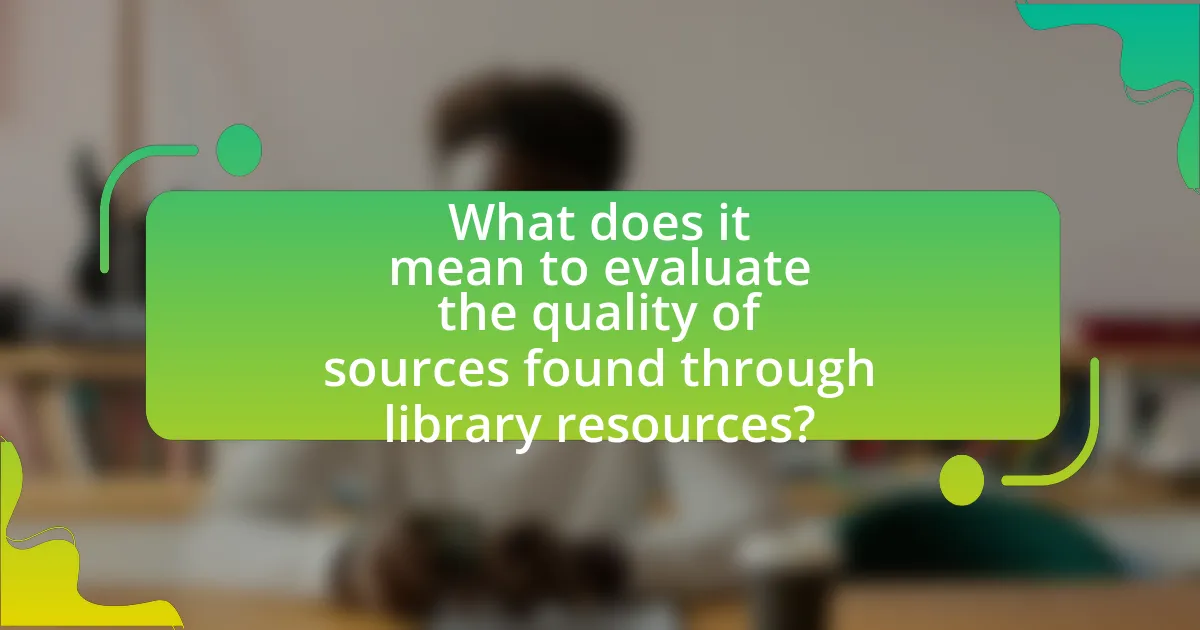
What does it mean to evaluate the quality of sources found through library resources?
Evaluating the quality of sources found through library resources means assessing the credibility, relevance, accuracy, and authority of the information presented in those sources. This process involves examining factors such as the author’s qualifications, the publication’s reputation, the date of publication, and the presence of citations or references. For instance, scholarly articles from peer-reviewed journals are generally considered high-quality sources due to their rigorous review process, while websites lacking credible authorship may be deemed less reliable.
Why is evaluating sources important in research?
Evaluating sources is important in research because it ensures the credibility and reliability of the information being used. Reliable sources provide accurate data, which is essential for forming valid conclusions and supporting arguments. For instance, a study published in the Journal of Research Evaluation found that using high-quality sources significantly improves the overall quality of research outcomes. By critically assessing the authority, accuracy, and relevance of sources, researchers can avoid misinformation and enhance the integrity of their work.
What criteria should be used to assess the quality of sources?
To assess the quality of sources, one should evaluate criteria such as authority, accuracy, objectivity, currency, and coverage. Authority refers to the credentials and expertise of the author or organization behind the source, ensuring they are qualified to discuss the topic. Accuracy involves verifying the information against reliable references or data, confirming that it is free from errors. Objectivity assesses the source for bias, ensuring that it presents information fairly and without undue influence. Currency checks the timeliness of the information, as more recent sources are often more relevant, especially in rapidly changing fields. Finally, coverage examines the depth and breadth of the content, ensuring it comprehensively addresses the topic at hand. These criteria collectively help determine the reliability and usefulness of a source for research purposes.
How does the credibility of a source impact research outcomes?
The credibility of a source significantly impacts research outcomes by influencing the reliability and validity of the information presented. Credible sources, such as peer-reviewed journals and reputable institutions, provide accurate data and well-supported arguments, which enhance the overall quality of research findings. For instance, a study published in the Journal of the American Medical Association, which undergoes rigorous peer review, is more likely to yield trustworthy results compared to a blog post lacking editorial oversight. This reliance on credible sources ensures that researchers build their work on a solid foundation, ultimately leading to more robust conclusions and informed decision-making.
What types of sources can be found in library resources?
Library resources typically include a variety of source types such as books, academic journals, magazines, newspapers, databases, and multimedia materials. Books provide comprehensive coverage of topics, while academic journals offer peer-reviewed research articles that contribute to scholarly discourse. Magazines and newspapers deliver current events and general interest articles, and databases serve as repositories for a wide range of digital content, including e-books and articles. Multimedia materials encompass audio and video resources that enhance learning and research. These diverse sources ensure that library users have access to a broad spectrum of information for their research needs.
What are primary and secondary sources, and how do they differ?
Primary sources are original materials created during the time under study, such as diaries, photographs, and official documents. Secondary sources, on the other hand, analyze, interpret, or summarize primary sources, including textbooks, articles, and biographies. The key difference lies in their nature: primary sources provide direct evidence or firsthand accounts, while secondary sources offer commentary or analysis based on those primary materials. For example, a research article discussing a historical event would be a secondary source, while a letter written by someone who experienced that event would be a primary source.
How do scholarly articles differ from popular publications?
Scholarly articles differ from popular publications primarily in their purpose, audience, and level of research rigor. Scholarly articles are written for an academic audience and are typically peer-reviewed, meaning they undergo a formal evaluation process by experts in the field before publication. This process ensures that the research presented is original, credible, and contributes to the body of knowledge in a specific discipline. In contrast, popular publications are aimed at a general audience, often prioritize entertainment or general interest, and do not usually undergo rigorous peer review. For example, a study published in the Journal of the American Medical Association is subjected to strict peer review, while an article in a magazine like Time may not be fact-checked to the same extent. This distinction highlights the reliability and depth of scholarly articles compared to the more superficial nature of popular publications.
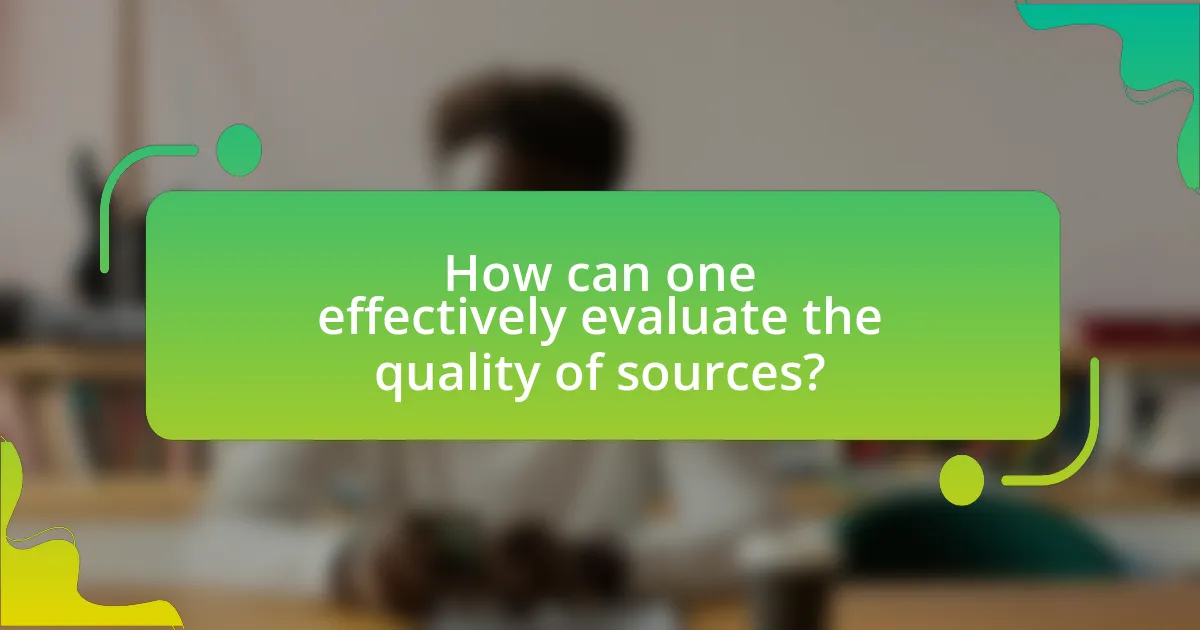
How can one effectively evaluate the quality of sources?
To effectively evaluate the quality of sources, one should assess the credibility, relevance, accuracy, and purpose of the information. Credibility can be determined by examining the author’s qualifications, the publication’s reputation, and the presence of citations or references. Relevance involves ensuring the source directly addresses the research topic or question. Accuracy requires checking the information against other reliable sources and verifying facts. Lastly, understanding the purpose helps identify any potential bias or agenda behind the information presented. These criteria are supported by research from the American Library Association, which emphasizes the importance of critical evaluation in information literacy.
What steps should be taken to assess a source’s reliability?
To assess a source’s reliability, one should evaluate the author’s credentials, the publication’s reputation, the source’s citations, and the date of publication. First, verifying the author’s qualifications and expertise in the subject matter establishes credibility; for instance, an author with a Ph.D. in a relevant field is generally more reliable than a non-expert. Next, examining the publication’s reputation, such as whether it is peer-reviewed or published by a reputable organization, further indicates reliability. Additionally, checking the citations within the source helps determine the quality of the information presented; reliable sources often reference other credible works. Finally, considering the date of publication is crucial, as more recent sources may provide updated information, especially in rapidly evolving fields. These steps collectively ensure a thorough assessment of a source’s reliability.
How can one identify the author’s qualifications and expertise?
One can identify an author’s qualifications and expertise by examining their educational background, professional experience, and published works. Educational credentials, such as degrees from accredited institutions, indicate the author’s formal training in their field. Professional experience, including job titles and roles in relevant organizations, provides insight into their practical knowledge and skills. Additionally, reviewing the author’s publications in peer-reviewed journals or books demonstrates their contributions to the field and recognition by other experts. These factors collectively establish the author’s credibility and authority on the subject matter.
What role does the publication date play in source evaluation?
The publication date is crucial in source evaluation as it indicates the timeliness and relevance of the information presented. Recent publications are often more reliable for current topics, reflecting the latest research, trends, and developments. For instance, in fields like technology or medicine, information can become outdated quickly; thus, a source published within the last few years is typically preferred. Conversely, older sources may still hold value for historical context or foundational theories, but their applicability to current issues may be limited. Therefore, assessing the publication date helps determine the source’s relevance and reliability in relation to the topic being researched.
What tools and resources are available for evaluating sources?
Tools and resources available for evaluating sources include academic databases, citation analysis tools, and evaluation checklists. Academic databases such as JSTOR and PubMed provide peer-reviewed articles, ensuring credibility. Citation analysis tools like Google Scholar and Scopus allow users to assess the impact and relevance of sources based on citation counts. Evaluation checklists, such as the CRAAP test (Currency, Relevance, Authority, Accuracy, Purpose), offer a structured approach to assess the quality of information. These resources collectively enhance the ability to critically evaluate the reliability and validity of sources found through library resources.
How can library databases assist in source evaluation?
Library databases assist in source evaluation by providing access to peer-reviewed articles, scholarly journals, and credible publications that have undergone rigorous editorial processes. These databases often include tools for filtering results based on criteria such as publication date, author credentials, and citation metrics, which help users assess the reliability and relevance of sources. For instance, databases like JSTOR and PubMed offer advanced search options that allow researchers to locate high-quality materials quickly, ensuring that the information they use is both accurate and trustworthy.
What online tools can help assess the credibility of sources?
Online tools that can help assess the credibility of sources include FactCheck.org, Snopes, and the CRAAP Test. FactCheck.org provides nonpartisan analysis of political claims, ensuring information accuracy. Snopes is widely recognized for debunking myths and verifying urban legends, making it a reliable resource for fact-checking. The CRAAP Test, which stands for Currency, Relevance, Authority, Accuracy, and Purpose, offers a systematic approach to evaluate the credibility of sources by examining these five criteria. These tools are essential for ensuring the reliability of information, especially in an era of misinformation.

What common pitfalls should be avoided when evaluating sources?
Common pitfalls to avoid when evaluating sources include failing to assess the credibility of the author, neglecting to check the publication date, and overlooking the source’s purpose or bias. Evaluators should ensure that the author has relevant qualifications and expertise in the subject matter, as this directly impacts the reliability of the information presented. Additionally, using outdated sources can lead to misinformation, especially in rapidly changing fields like technology and medicine. Lastly, understanding the intent behind the source—whether it aims to inform, persuade, or sell—can reveal potential biases that may skew the information. These factors are critical for ensuring the quality and accuracy of the sources utilized in research.
What biases can affect the evaluation of sources?
Cognitive biases can significantly affect the evaluation of sources. Confirmation bias leads individuals to favor information that supports their pre-existing beliefs while disregarding contradictory evidence. Anchoring bias occurs when an initial piece of information unduly influences subsequent judgments, causing evaluators to rely too heavily on that first impression. Additionally, authority bias can result in overvaluing sources simply because they are produced by recognized experts, regardless of the content’s actual quality. Research indicates that these biases can distort critical thinking and lead to poor decision-making in source evaluation, as shown in studies on cognitive psychology and information literacy.
How can confirmation bias influence research outcomes?
Confirmation bias can significantly influence research outcomes by leading researchers to favor information that supports their pre-existing beliefs while disregarding contradictory evidence. This cognitive bias can result in skewed data interpretation, where researchers may selectively highlight findings that align with their hypotheses, ultimately compromising the objectivity and validity of their conclusions. For instance, a study published in the journal “Psychological Bulletin” by Nickerson (1998) illustrates how confirmation bias can distort the research process, as individuals tend to search for, interpret, and remember information in a way that confirms their prior beliefs. This bias can undermine the quality of sources evaluated through library resources, as researchers may overlook critical literature that challenges their views, thereby affecting the overall integrity of their research outcomes.
What are the dangers of relying on anecdotal evidence?
Relying on anecdotal evidence poses significant dangers, primarily due to its lack of scientific rigor and potential for bias. Anecdotal evidence is based on personal accounts rather than systematic research, which can lead to misleading conclusions. For instance, a single positive experience with a treatment does not account for the broader population’s response, potentially skewing perceptions of its effectiveness. Additionally, anecdotal evidence is often influenced by cognitive biases, such as confirmation bias, where individuals favor information that supports their existing beliefs. This can result in the propagation of misinformation, as seen in health-related claims that lack empirical support. Therefore, the reliance on anecdotal evidence can undermine informed decision-making and lead to harmful outcomes.
How can one ensure a comprehensive evaluation process?
To ensure a comprehensive evaluation process, one must systematically assess sources based on criteria such as authority, accuracy, relevance, and currency. This structured approach allows for a thorough examination of each source’s credibility and applicability to the research topic. For instance, a study published in the Journal of Academic Librarianship highlights that evaluating the author’s qualifications and the publication’s reputation significantly impacts the reliability of the information. By applying these criteria consistently, researchers can effectively determine the quality of sources obtained through library resources.
What strategies can be employed to cross-check information?
To cross-check information effectively, one can employ strategies such as verifying facts against multiple reputable sources, utilizing fact-checking websites, and consulting primary sources. Verifying facts against multiple reputable sources ensures that the information is consistent and corroborated, which is essential for accuracy. For instance, if a claim is reported by both a peer-reviewed journal and a respected news outlet, it is more likely to be credible. Utilizing fact-checking websites like Snopes or FactCheck.org provides an additional layer of verification, as these platforms specialize in assessing the accuracy of claims. Consulting primary sources, such as original research studies or official documents, allows for direct access to the data and context, further enhancing the reliability of the information. These strategies collectively contribute to a thorough evaluation of the quality of sources found through library resources.
How can peer reviews enhance the evaluation of sources?
Peer reviews enhance the evaluation of sources by providing a rigorous assessment of the research quality and credibility. This process involves experts in the field critically analyzing the methodology, findings, and relevance of a study before publication, ensuring that only high-quality research is disseminated. For instance, studies published in peer-reviewed journals are often considered more reliable, as they have undergone scrutiny by multiple experts, which helps to identify biases, errors, or unsupported claims. This validation process increases the trustworthiness of the sources, making them more valuable for academic and professional use.
What best practices should be followed when evaluating sources?
When evaluating sources, best practices include assessing the credibility, relevance, accuracy, and bias of the information. Credibility can be determined by examining the author’s qualifications, the publication’s reputation, and the presence of citations or references. Relevance involves ensuring the source directly addresses the research topic or question. Accuracy requires verifying the information against other reliable sources, while bias assessment involves identifying any potential slant or agenda that may affect the objectivity of the content. Following these practices enhances the reliability of the sources used in research.
How can one create a checklist for source evaluation?
To create a checklist for source evaluation, one should identify key criteria that assess the credibility and relevance of sources. Essential criteria include authority (the author’s qualifications), accuracy (the reliability of the information), objectivity (the presence of bias), currency (the timeliness of the information), and coverage (the depth and breadth of the content).
For instance, checking the author’s credentials can confirm their expertise in the subject matter, while verifying the publication date ensures the information is up-to-date. Additionally, evaluating the source’s purpose can reveal potential biases, which is crucial for determining objectivity. This structured approach allows for a systematic evaluation of sources, ensuring that only high-quality materials are utilized in research.
What are the benefits of maintaining a critical mindset during evaluation?
Maintaining a critical mindset during evaluation enhances the ability to discern the quality and reliability of sources. This approach allows evaluators to identify biases, assess the credibility of authors, and determine the relevance of information to their research needs. For instance, a study published in the Journal of Information Science found that critical evaluation skills significantly improve the accuracy of source selection, leading to more informed decision-making in academic research. By applying a critical mindset, individuals can avoid misinformation and ensure that their conclusions are based on sound evidence.
